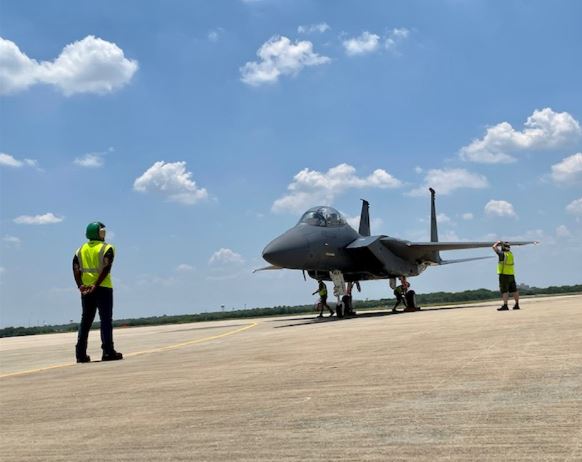
The first two U.S. Air Force F-15E aircraft recently began Eagle Passive Active Warning and Survivability System (EPAWSS) modification at Boeing. (Photo, courtesy of Boeing)
Boeing has begun modifying two F-15E Strike Eagles with the Eagle Passive Active Warning and Survivability System (EPAWSS), which is also to go on the U.S. Air Force’s F-15EX Eagle II fighters, the company said on July 21.
Boeing said that the Air Force plans to equip 43 of the service’s F-15Es with EPAWSS, which a Boeing/BAE Systems team supplies. That number would seem to indicate a ratcheting back of Air Force plans for F-15E EPAWSS upgrades, as the Air Force had projected last year that it would outfit all 217 service F-15Es with EPAWSS. The Strike Eagles have an average age of more than 29 years.
In March last year, BAE Systems said that it had begun low-rate initial production of EPAWSS for the F-15E under a $58 million subcontract from Boeing.
“In May, 2021, the first two F-15EX aircraft, delivered ahead of schedule, participated in Northern Edge exercises with the EPAWSS suite,” Boeing said. “During the highly contested and complex exercises, the two jets demonstrated operational potential, which set the stage for future incremental improvements, allowing the jets to exhibit proven, outstanding performance in subsequent exercises and flight test missions in October, 2021 and February, 2022.”
In April, Rep. Vicky Hartzler (R-Mo.), the vice chair of the House Armed Services Committee’s tactical air and land forces panel, expressed concern about Air Force plans to cut the F-15EX acquisition objective from 144 to 80 aircraft.
EPAWSS is to replace the F-15’s Northrop Grumman-built Tactical Electronic Warfare System self-protection suite, a 1970s-era system which is “functionally obsolete” and costly to sustain, the Air Force has said.
The Air Force has estimated that for all F-15Es EPAWSS may cost $2.7 billion for Increment 1, which covers through 2023, and Increment 2 thereafter.
Increment 1 replaces the existing radar warning receiver, internal countermeasure system and countermeasure dispenser system, while Increment 2 is to add a towed decoy and monopulse angle countermeasure capability.
The Air Force has said that EPAWSS will significantly improve the F-15E’s ability to counter radio frequency, electro-optical, and infrared threats in highly contested environments through 2040.
During the EPAWSS Engineering and Manufacturing Phase, BAE Systems has said that it plans to add geolocation and threat identification features to the EPAWSS flight software.
This article was first published by Defense Daily, a sister publication to Avionics International, it has been edited. Click here to view the original version.